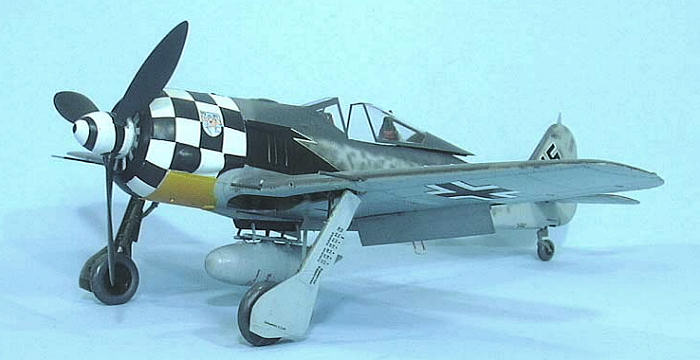
Hasegawa 1/32 FW-190A-6 'Checker Nose'
| KIT #: | 08162 |
| PRICE: | $Out of Production |
| DECALS: | Three aircraft |
| REVIEWER: | Tom Cleaver |
| NOTES: | Limited release boxing |

| HISTORY |
However, the main use of the Fw-190A-6 - and the reason for its existence with
its heavy armament - was on the Western Front, where the USAAF’s 8th
Air Force was gathering strength and reaching out across Western Europe and into
Germany in the spring and summer of 1943 when the A-6 made its appearance.
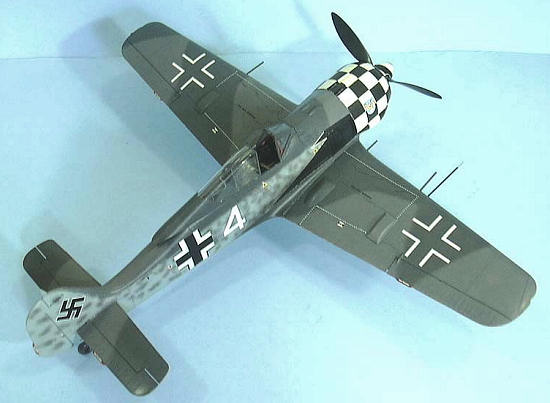 While the Fw-190A was always the German fighter with the best armament for
opposing heavy bombers, it was at a disadvantage against the Americans, since
the Wurger’s best altitude performance
was at approximately 23,000 feet, and the American bombers were coming in at
25,000-27,000 feet.
Thus, by the time the Fw-190-equipped units struggled up
to 28,000 to 29,000 feet to make their famous “twelve o’clock high” head-on
attacks against the bombers, they were at a serious disadvantage if they ran
across any opposing P-47s - which would be operating at their best height at
that altitude.
While the Fw-190A was always the German fighter with the best armament for
opposing heavy bombers, it was at a disadvantage against the Americans, since
the Wurger’s best altitude performance
was at approximately 23,000 feet, and the American bombers were coming in at
25,000-27,000 feet.
Thus, by the time the Fw-190-equipped units struggled up
to 28,000 to 29,000 feet to make their famous “twelve o’clock high” head-on
attacks against the bombers, they were at a serious disadvantage if they ran
across any opposing P-47s - which would be operating at their best height at
that altitude.
Thus, the JagdGeschwadern opposing the
Americans - JG 2 over the Cotentin Peninsula in western France, JG 26 in
northern France and southern Belgium, and JG 1 in northern Belgium and Holland -
were forced in the spring of 1943 to change from being solely equipped with
Fw-190s in all Gruppen to having two
Gruppen on the Fw-190 and the third
flying the Bf-109G-2 and later Bf-109G-4, which could fly and fight at altitudes
above 30,000 feet.
The responsibility of the 109s was to cover the 190s and
keep the fighters away while the 190s concentrated on the bombers.
Unfortunately, the Germans were about as successful with
this tactic as the RAF had been assigning Spitfires to cover Hurricanes and take
on the Luftwaffe’s 109s while the
Hurricanes took on the Heinkels and Dorniers during the Battle of Britain.
As the summer of 1943 wore on and the P-47s of the 8th
Air Force acquired the ability to reach out further from England to the west
German border, the Fw-190s found themselves more and more frequently fighting
off Thunderbolts while trying to set up for a “company front” attack on the
bomber screen.
It was in these early battles that the
Luftwaffe began hemorrhaging the one commodity they
couldn’t afford to lose: experienced pilots.
Within six months of the first Schweinfurt mission in
August 1943, the Jagdwaffe would be a
shadow of its former self after fighting off the deep-penetration missions in
February and March 1944.
But so long as the Americans lacked the ability to escort the bombers all the
way to their distant targets and back, the Luftwaffe
exacted such a toll on the bombers than a B-17 or B-24 crewman on his sixth
mission was statistically flying another man’s time, since the life expectancy
of a bomber crewman in 1943 was five missions - with 25 required to complete a
tour.
Anyone today who has ever been inside “9-0-9" or “Aluminum Overcast” or
“Sentimental Journey” or “All American” and seen how small they are, how
vulnerable they are, can only come away with a sense
 of awe at the thought of
facing a German fighter with four 20mm cannons, each capable of firing 600
rounds a minute, at a frigid 25,000 feet over Europe.
of awe at the thought of
facing a German fighter with four 20mm cannons, each capable of firing 600
rounds a minute, at a frigid 25,000 feet over Europe.
For the Germans, fighting the Americans was unlike anything they had done before
on the Channel Front.
Previously, the incoming formations were relatively
small, and could be opposed by individual Staffeln.
But going up against 200 or 300 heavy bombers, with
their escorts, meant sending up units in full Gruppe strength, if not the entire
Geschwader.
Aerial recognition of friend and foe became as important for the
Germans as it was for the Americans, since the Fw-190 and the P-47 looked so
much alike at a distance.
While the 8th
Air Force was painting white recognition bands on the nose and tail of their
P-47s, the German units were experimenting with markings that were even more
obvious.
Psychologically, the Germans in 1943 considered themselves to have the
upper hand over the Americans (which was quite often the case) and so they could
decide that more radical markings, more obvious markings, could be used since
they were also a morale factor for everyone - German and American - involved.
For I/JG 1 in the summer and fall of 1943, this resulted
in what were probably the most spectacular markings carried by any German
fighters in the war - a checker board on the cowlings - with the individual
Staffeln in the
Gruppe identified by different colors in the field - white
for the 1st Staffel,
yellow for the 2nd, and red for the
3rd - each with black checkers on
the board.
Additionally, many of the aircraft also carried their
Staffel badge superimposed on the checker board.
The result was that I Gruppe could easily identify each
other, and psychologically the enemy knew who they were up against.
 These markings lasted through the winter of 1943-44, while losses were
comparatively low.
In fact, after “Black Thursday,” the second Schweinfurt
mission of October 14, 1943, when the Jagdwaffe brought down 60 of 290 American
bombers and damaged another 100, 70 of them so badly they never flew after
regaining their bases, the 8th Air
Force was unable to mount an offensive mission.
The Luftwaffe
had won almost as decisively as had the RAF on September 15, 1940.
The Americans were able to hide this defeat by the luck
of the weather - the skies over Western Europe closed in the week following the
Schweinfurt disaster and didn’t clear sufficiently for another deep-penetration
mission until early December.
By then the P-47s were carrying two drop tanks on
underwing pylons and a third under the fuselage, there were now two long range
P-38 units and the first P-51 unit was about to go operational.
Within two months, the shoe was on the other foot.
These markings lasted through the winter of 1943-44, while losses were
comparatively low.
In fact, after “Black Thursday,” the second Schweinfurt
mission of October 14, 1943, when the Jagdwaffe brought down 60 of 290 American
bombers and damaged another 100, 70 of them so badly they never flew after
regaining their bases, the 8th Air
Force was unable to mount an offensive mission.
The Luftwaffe
had won almost as decisively as had the RAF on September 15, 1940.
The Americans were able to hide this defeat by the luck
of the weather - the skies over Western Europe closed in the week following the
Schweinfurt disaster and didn’t clear sufficiently for another deep-penetration
mission until early December.
By then the P-47s were carrying two drop tanks on
underwing pylons and a third under the fuselage, there were now two long range
P-38 units and the first P-51 unit was about to go operational.
Within two months, the shoe was on the other foot.
With the losses in pilots and planes sustained in the missions of February and March 1944, the Germans no longer had the time to spend painting an airplane with elaborate markings, not to mention the Luftwaffe now needed to hide from their hunters. Bright markings became a thing of the past among the Jagdwaffe, with pilots even ceasing to paint victory markings on their rudders.
| THE KIT |
Over the years since Hasegawa first released their Fw-190 kits in 2003, they
have released limited editions, some of
different sub-types and some with different markings.
This kit of the Fw-190A-6 is both.
While Fw-190A-6s on the Eastern Front kept the early
gear doors since they were not carrying drop tanks, those used o n the Western
Front were the first Fw-190s to regularly use centerline drop tanks, which meant
they did not use the inner gear doors that covered the wheels.
Thus, this mix-and-match kit has the gear doors and
centerline drop tank and rack of the later Fw-190A-8, with the upper cowling and
gun bay cover of the earlier Fw-190A-5 kit.
The decals provide the black checkers, and markings for
an airplane from each of the three Staffeln,
with the modeler responsible for painting the cowling in the proper color.
The sheet does not include individual Staffel insignia;
however, I had the Cutting Edge He-162 sheet, which did have the different
squadron badges for each unit in I Gruppe,
and decided to go with the “Cloud Devil” insignia of 1st
Staffel.
n the Western
Front were the first Fw-190s to regularly use centerline drop tanks, which meant
they did not use the inner gear doors that covered the wheels.
Thus, this mix-and-match kit has the gear doors and
centerline drop tank and rack of the later Fw-190A-8, with the upper cowling and
gun bay cover of the earlier Fw-190A-5 kit.
The decals provide the black checkers, and markings for
an airplane from each of the three Staffeln,
with the modeler responsible for painting the cowling in the proper color.
The sheet does not include individual Staffel insignia;
however, I had the Cutting Edge He-162 sheet, which did have the different
squadron badges for each unit in I Gruppe,
and decided to go with the “Cloud Devil” insignia of 1st
Staffel.
| CONSTRUCTION |
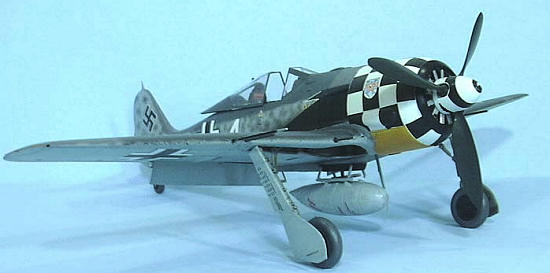 After as much practice as I have had, the “drill” is pretty easy:
After as much practice as I have had, the “drill” is pretty easy:
Fill the sink marks in the upper wing and the flaps with Mr. Surfacer (or now,
the Tamiya equivalent), paint the cockpit parts in Tamiya XF-63 “German Grey,”
paint the wheel wells and landing gear with Xtracrylix “RLM 02 Grey Green”,
paint the engine black and the accessories silver.
Then apply the instrument decals to the cockpit parts.
While these are setting up, assemble the Eduard seat
belts.
At this point, I also brush Tamiya “Smoke” over the wheel well and
landing gear parts, to simulate wear and oil smears.
When all is dry and set, I assemble the model per instructions. I love that this kit is designed in such a way that a modeler has to actively work to assemble it incorrectly and misalign the parts
| COLORS & MARKINGS |
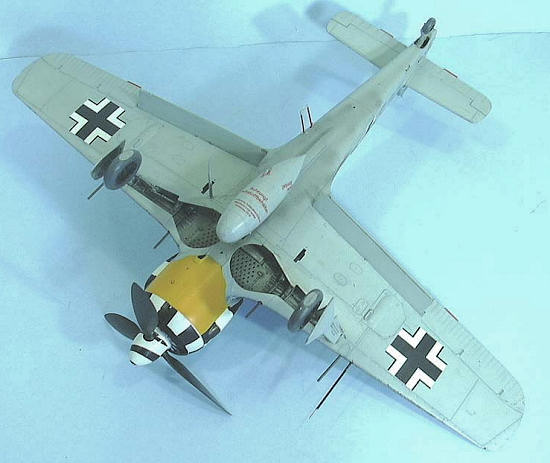 Painting:
Painting:
I airbrushed Tamiya “Flat White” on the cowling, then masked that off and
airbrushed the yellow ID panel on the lower cowling.
I then unmasked the cowling and hand-painted it with
thinned Xtracrylix “White.”
This paint dries very smooth, but there would be just
the tiniest trace of brush strokes, which would simulate the way the unit
applied their markings with brushes, as a couple of close-up photos revealed to
me.
I also painted the armored ring with Xtracrylix “Night Black.”
That was masked off and a traditional camouflage of RLM
74/75/76 was applied freehand, using Xtracrylix colors, which are dead-accurate.
When all that was dry, I unmasked the cowling and gave
the model a coat of Future
Decals:
Since this is a kit from the days when Hasegawa’s kit decals had an “ivory” white color, I only used the kit decals for the checkers and the stencils. I used national insignia from an Eagle Editions sheet, as well as the white “4.” Everything went down easily, once I applied a final coat of Solvaset atop the Micro-Sol on the national insignias, which were thicker than I had originally thought.
| FINAL CONSTRUCTION |
I gave the model two coats of Xtracrylix Flat Varnish, the second with a brushful of Tamiya “Flat Base” mixed in to lower the final sheen a bit. Since these airplanes were well cared-for at the time and weren’t flying operations every day as they would have on the Eastern Front, I only applied a thinned coat of Tamiya Semi-Gloss Black to simulate the exhaust stains. I then attached the landing gear and prop, and unmasked and opened the canopy.
| CONCLUSIONS |
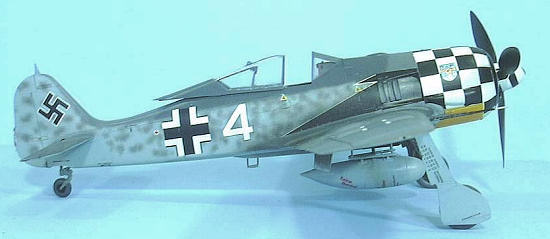 These “special edition” kits came and went to fast when they were
originally released that I never had the chance to get this one until I ran
across the kit at the local hobby shop in the sale of the collection of a
departed kit collector. Fortunately, I got to pay the original price of
$42.95, making this a real bargain.
This brightly-colored model looks very interesting
next to the others.
Now there’s just the Fw-190F-8 “Special Edition” kit
that I picked up last week, and my collection of Wurgers in their many
varieties will be complete (so you only have one more review of this series
of kits to suffer through).
I particularly recommend these kits to any modeler
who has limited time for the hobby - they’re quick to build, fun to paint,
and the result is guaranteed to look nice.
These “special edition” kits came and went to fast when they were
originally released that I never had the chance to get this one until I ran
across the kit at the local hobby shop in the sale of the collection of a
departed kit collector. Fortunately, I got to pay the original price of
$42.95, making this a real bargain.
This brightly-colored model looks very interesting
next to the others.
Now there’s just the Fw-190F-8 “Special Edition” kit
that I picked up last week, and my collection of Wurgers in their many
varieties will be complete (so you only have one more review of this series
of kits to suffer through).
I particularly recommend these kits to any modeler
who has limited time for the hobby - they’re quick to build, fun to paint,
and the result is guaranteed to look nice.
Review kit courtesy of my wallet.
January 2009
If you would like your product reviewed fairly and quickly, please contact me or see other details in the Note to Contributors.